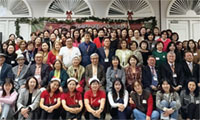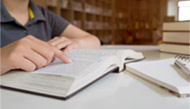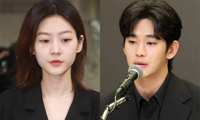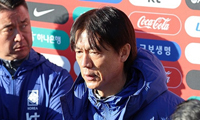Cityscapes: Greeting Another Language
Reprinted with Permission
from The Los Angeles Times
The school day begins in Ms. Kim’s class at Los Angeles High not with "Good morning" or "Buenos dias," but with "Ahn-young-ha-sae-yo."
"Ahn-young-ha-sae-yo!" students say to their teacher and one another as they enter Room l65, a cheerful place bedecked with colorful displays of students’ photographs and other works.
There is much laughter as learners of Korean string together their newly acquired vocabulary to converse with their teacher and classmates.
Two words in particular give them trouble: ohjae (yesterday) and onjae (when).
After repeating ohjae and onjae several times with them, Kim advises: "Just remember: O.J. (Simpson) is yesterday’s story."
More than l00 Los Angeles High School students are learning Korean from Young-Hwa Kim, who developed the Korean language curriculum and began teaching it three years ago, after Korean was approved as an achievement test portion of the SAT exam.
It is the Los Angeles Unified School District’s only full-time Korean language program. Korean is taught in 35 secondary schools in the country, l7 of them in Southern California, according to the Koreatown-based Foundation for SAT II Korean.
Los Angeles High is at the edge of Koreatown, but its student population might make it seem an unlikely place for the language classes: 75% Latino, l4% black and 7% Asian, with a small mix of others. About 80% of Kim’s students are non-Korean, mostly Latinos who get a chance to use the language in the neighborhood.
Many of Kim’s non-Korean students have become so accustomed to hearing Korean that saying nae (yes) and aniyo (no) is second nature to them.
Kara and Anna Cruz, Filipino American twins in Kim’s beginner class, have even adopted the Korean custom of bowing when saying Ahn-young-ha-sae-yo? Meaning, "Are things well with you?"
The sisters say they were motivated to learn Korean because they have so many Korean neighbors and they attend St. Basil’s Catholic Church in the Mid-Wilshire district, which includes a Korean congregation.
"I always wanted to read what was written in Korean. I also wanted to read their bulletin, which is in Korean," says Kara.
Korean grammar and sentence structure are hard, Anna says. So she says she studies at least 30 minutes a day, repeating new words, then typing them over and over into her computer.
Kara, meanwhile, often tests her Korean. "After doing my homework and studying Korean at home, I practice it when doing grocery shopping with my mother at a Korean market," she says.
Today’s assignment in the beginners class, composed mostly of ninth-graders, is writing a poem in Korean about an emotion. Students are to choose from love, happiness, loneliness, peacefulness, sadness, fear, hatred or anger. Then they must describe the color, sound, taste, smell and feel of the emotion. Finally, they are to capture the emotion in a drawing.
The students are busy creating. First they write in English, then they translate into Korean.
Some flip through their English-Korean dictionaries. Others consult their classmates and printed material their teacher has given them. Still others raise their hands and call out "Kim sonsaeng-nim, Kim sonsaeng-nim" (teacher Kim) for help.
Fear is the subject of Los Angeles-born David Gonzalez’s poem:
Fear is red pepper
Fear sounds like high school kids running around
Fear tastes like garlic, onion and radish
Fear smells like Western food that has a lot of fat
Fear is like dancing with pain
Fear is like sadness and hatred and anger
Fear is worse than kindergarten students
Fear is not like an apple or a cherry
Fear is like a potato
A drawing of two red chili peppers adorns the poem.
Kim is pleased with what she sees. Stopping at each desk, she and two student teachers go over the poems and correct with a green felt pen errors in the phonetic Korean script called hangul.
Invented in l443 by a team of scholars under the direction of a Korean king named Sejong, the 24-letter hangul alphabet enabled the masses to read and write. Until then, Koreans used Chinese ideograms, which were mastered only by the educated upper classes.
A novice can master the alphabet quickly. But getting a firm grasp of the language is quite another matter. Even for the best students, it could take three years, Kim says.
Korean American teenagers enroll mainly in Kim’s advanced classes to practice their reading and writing.
"Korean is a difficult language to learn," acknowledges Kim, who earned a degree in Korean from the prestigious Ewha Womans University in Seoul in l973. "Some pick up Korean much more easily than others. I try to meet each student where he or she is."
David Gonzalez, who wrote the poem on fear, concedes the difficulty but says he enjoys studying Korean because "it’s not like anything I’ve studied before."
In addition to five hours of class time a week, he puts in at least 20 minutes a day at home.
"I keep pronouncing the words I learn and keep writing them down-over and over again," he says.
Jose Segura, a senior who is completing his fourth semester of Korean, says he enjoys being able to understand when Korean is spoken, such as when his family was invited to the home of his father’s employer, an auto shop owner.
"When we visited his boss’ home, we had to take off our shoes," he says. But he wasn’t offended because he knew that is a Korean custom.
"Each culture has its place; we need to teach students to respect that," Kim says. "So much of friction [comes] from ignorance."
Learning a language is a key. Too many people, the teacher stresses, "refuse to even acknowledge the power of language and cultural embrace among our own."
One of the most difficult aspects of Korean is the layers of honorifics, requiring the speaker to pay attention to age, social status and education in even the simplest of exchanges.
This is one reason many Korean Americans proficient in both languages prefer to converse in English among themselves. In English, even a child can say "you" to his grandfather. But to do that in Korean would be insulting.
The honorific form of the Ahn-young-ha-sae-yo greeting is Ahn-young-hashim-nika, Kim reminds her students.
They aren’t worrying about the intricacies of honorifics yet. But she sometimes uses the form to familiarize them with it.
One of her recent assignments was to send students to a Koreatown restaurant to check out the menus and converse with the proprietor.
During one of those visits, a student got free pastry.
"When he told the proprietor bissayo (it’s expensive), she was so delighted {to hear a non-Korean speak in Korean] that she didn’t charge him," Kim recalls.
In Room l65, Kim says learning is a two-way street.
"I have a student from Nicaragua who corrected my pronunciation of Nicaragua until I got it right," she says.
"My students crack me up. Sometimes when I go home after school, I am dead tired. But when I think of them, I start laughing by myself. Even some of the rascals are cute. I have so much fun with those kids."
스마터리빙
more [ 건강]
[ 건강]이제 혈관 건강도 챙기자!
[현대해운]우리 눈에 보이지 않기 때문에 혈관 건강을 챙기는 것은 결코 쉽지 않은데요. 여러분은 혈관 건강을 유지하기 위해 어떤 노력을 하시나요?
 [ 건강]
[ 건강]내 몸이 건강해지는 과일궁합
 [ 라이프]
[ 라이프]벌레야 물럿거라! 천연 해충제 만들기
 [ 건강]
[ 건강]혈압 낮추는데 좋은 식품
[현대해운]혈관 건강은 주로 노화가 진행되면서 지켜야 할 문제라고 인식되어 왔습니다. 최근 생활 패턴과 식생활의 변화로 혈관의 노화 진행이 빨라지고
사람·사람들
more많이 본 기사
- 트럼프, ‘의회폭동 다큐’ BBC에 100억 달러 명예훼손 손배소
- 젤렌스키 “푸틴이 종전안 거부하면 미국에 장거리 무기 요청”
- “과부랑은 결혼해도 이혼녀는 절대 안 돼”…뿌리 깊게 박힌 편견, 中 차별 역사 보니
- 대장동 ‘범죄수익 찾기’ 본격화…김만배·남욱, 추징해제 청구
- 경찰, 김건희특검 상대 추가 압수수색…내일 한학자 접견조사
- 테슬라 주가 올들어 최고…사상 최고치도 연내 경신하나
- “197명 아빠 된 정자 기증자, ‘암 위험 90%’ 돌연변이 보유자였다”…10명 이미 암 진단
- 우크라인 75% “확고한 안전보장 없이 러 유리 종전안 수용 불가”
- 미국, 무역합의 이행 늦다며 최우방 영국에 AI협력 일시중단
- ‘10명 탑승’ 항공기 멕시코서 추락… “최소 6명 사망”
- 尹 ‘체포방해 혐의’ 내달 16일 선고…4개 재판 중 첫 결론
- ‘핀테크 원조’ 페이팔, 미국서 은행 설립 나서
- 한국 3월 A매치 상대 한 팀 사실상 확정... 오스트리아 감독 ‘평가전 인정’
- 통일교 등 압수수색 15시간만 종료…회계자료·휴대전화 확보
- ‘최고 부자’ 머스크 자산 6천770억달러 돌파…”최초 조만장자 눈앞”
- 마약딛고 함께 영화도 만들었는데…라이너감독 살해한 아들 체포
- 美, 반중 언론인 지미 라이 석방 촉구… “표현의 자유 침묵시켜”
- 트럼프, MAGA 내부서도 식나… ‘매우 지지’ 8개월새 8%p 하락
- 국과수 “김수현·故 김새론 녹취파일, AI 조작 판정 불가”
- LA서 ‘새해벽두 폭탄테러’ 모의 일당 체포… “기업들 공격 시도”
- 트럼프, 합성마약 펜타닐을 ‘대량살상무기’로 지정
- 유럽, 우크라 안전보장 다국적군 제안…유럽 주도하고 미국 지원
- 대기천 워싱턴주 강타 역대급 홍수 ...워싱턴주 서부 이례적인 대기천 폭우로 역대급 홍수 발생
- 뉴욕증시, AI 회피 심리 지속…하락 마감
- 관세가 끌어올린 물가… 가구당 1,200달러 추가 지출
- ‘美정부가 대주주’ 인텔, 대관담당으로 트럼프 보좌관 영입
- ‘해리가 샐리를 만났을 때’ 롭 라이너 감독 부부 피살
- [경제 트렌드] 외식비 줄이는 소비자… ‘팁 공포’ 한몫
- 뉴욕 백화점서 아기 기저귀 갈던 엄마, 정신질환자에 흉기피습
- 대학 진학에 도움되는 AP… 적합한 과목 적절히 선택해야
- ‘우미노시즈쿠 후코이단’ 감사 이벤트
- “내 한국인 남편, 40일 넘게 개처… 1
- 지구촌 또 ‘총기 난사’… 미·호주 잇단 참사
- 항공기 승객정보 활용 추방 확대
- 브라운대 총격사건 수사 난항 겪나…체포한 용의자 석방
- 역시 호날두! 북중미 WC 인기 티켓 1위는? 포르투갈-콜롬비아전... 3위가 한국-멕시코전 “개최국 효과”
- 투고(To Go) 해야 하나?
- 트럼프, 합성마약 펜타닐을 ‘대량살상무기’로 지정
- 오레곤문인협회 신임 회장에 김인자 시인...11일 정기총회서…김혜자 직전회장 6년간 헌신 다해
- 피로 얼룩진 주말…지구촌 곳곳 총격사건 잇달아
- ‘15년째 활동 無’ 원빈 근황, 이시언 유튜브서 공개..”잘 지내는 중”
- 미·우크라 이틀간 종전협상…안전보장 진전, 영토 문제 난항
- 트럼프, 라이너감독 피살에 “나에 대한 발작적 집착이 분노유발”
- ‘128개 홈디포 매장서 319건 절도’ 플러싱 기반 전문절도단 일망타진
- 워싱턴 한국학교협의회, 제37회 교사의 밤
- ‘오염 하수 옥신각신’ 미국·멕시코 새 협약 합의
- 멕시코의 최대 50% 관세 배경 설명, ‘트럼프 복사판’
- 테슬라 11월 미국 판매… 4년만에 최저
- 퇴조의 핑크 타이드
- 오늘의 베네수엘라가 내일의 동아시아국… 2
1/5지식톡

-
 ☝️해외에서도 가능한 한국어 선생님…
0
☝️해외에서도 가능한 한국어 선생님…
0이 영상 하나면 충분합니다!♥️상담신청문의♥️☝️ 문의 폭주로 '선착순 상담'만 진행합니다.☎️ : 02-6213-9094✨카카오톡ID : @GOODEDU77 (@골뱅이 꼭 붙여주셔야합니다…
-
 테슬라 자동차 시트커버 장착
0
테슬라 자동차 시트커버 장착
0테슬라 시트커버, 사놓고 아직 못 씌우셨죠?장착이 생각보다 쉽지 않습니다.20년 경력 전문가에게 맡기세요 — 깔끔하고 딱 맞게 장착해드립니다!장착비용:앞좌석: $40뒷좌석: $60앞·뒷좌석 …
-
 식당용 부탄가스
0
식당용 부탄가스
0식당용 부탄가스 홀세일 합니다 로스앤젤레스 다운타운 픽업 가능 안녕 하세요?강아지 & 고양이 모든 애완동물 / 반려동물 식품 & 모든 애완동물/반려동물 관련 제품들 전문적으로 홀세일/취급하는 회사 입니다 100% …
-
 ACSL 국제 컴퓨터 과학 대회, …
0
ACSL 국제 컴퓨터 과학 대회, …
0웹사이트 : www.eduspot.co.kr 카카오톡 상담하기 : https://pf.kakao.com/_BEQWxb블로그 : https://blog.naver.com/eduspotmain안녕하세요, 에듀스팟입니다…
-
 바디프렌드 안마의자 창고 리퍼브 세…
0
바디프렌드 안마의자 창고 리퍼브 세…
0거의 새제품급 리퍼브 안마의자 대방출 한다고 합니다!8월 23일(토)…24일(일) 단 이틀!특가 판매가Famille: $500 ~ $1,000Falcon: $1,500 ~ $2,500픽업 & 배송직접 픽업 가능LA…
케이타운 1번가
오피니언
 옥세철 논설위원
옥세철 논설위원오늘의 베네수엘라가 내일의 동아시아국가…

퇴조의 핑크 타이드
 조지 F·윌 워싱턴포스트 칼럼니스트
조지 F·윌 워싱턴포스트 칼럼니스트 [조지 F. 윌 칼럼] 대통령의 전쟁수행권
 조옥규 수필가
조옥규 수필가 투고(To Go) 해야 하나?
 신경립 / 서울경제
신경립 / 서울경제 [만화경] ‘뒷마당’ 찾겠다는 트럼프식 먼로주의

22기 LA평통 출범에 거는 기대

연말 시즌 사기·범죄 경계해야
 메건 매카들 워싱턴포스트 칼럼니스트
메건 매카들 워싱턴포스트 칼럼니스트 [메건 매카들 칼럼] 장편영화의 마지막 챕터인가
 김미선 서북미문인협회 회장시인
김미선 서북미문인협회 회장시인 [한국춘추] 하늘을 계산한 사람들, 칠정산
1/3지사별 뉴스

피로 얼룩진 주말…지구촌 곳곳 총격사건 잇달아
지난 주말 동안 미동부 아이비리그 브라운대학에서 총격 사건이 발생, 최소 2명이 사망하고 9명이 부상한데 이어 호주 시드니에서는 사망자 16…
뉴욕·뉴저지 등 19개 주정부 H-1B비자‘10만달러 수수료’소송

워싱턴 한국학교협의회, 제37회 교사의 밤
재미한국학교 워싱턴지역협의회(회장 정광미)가 13일 ‘제 37회 교사의 밤’을 개최, 한 해 동안 헌신한 교사들의 노고를 위로했다. 올해 최우…
안수화 회장 연임 확정

트럼프, 합성마약 펜타닐을 ‘대량살상무기’로 지정
도널드 트럼프 대통령은 15일 신종 합성마약으로 미국에 대량 유입된 펜타닐을 ‘대량살상무기’(WMD)로 지정했다.트럼프 대통령은 이날 백악관에…
‘우미노시즈쿠 후코이단’ 감사 이벤트

오늘 하루 이 창 열지 않음 닫기 





















































.png)


댓글 안에 당신의 성숙함도 담아 주세요.
'오늘의 한마디'는 기사에 대하여 자신의 생각을 말하고 남의 생각을 들으며 서로 다양한 의견을 나누는 공간입니다. 그러나 간혹 불건전한 내용을 올리시는 분들이 계셔서 건전한 인터넷문화 정착을 위해 아래와 같은 운영원칙을 적용합니다.
자체 모니터링을 통해 아래에 해당하는 내용이 포함된 댓글이 발견되면 예고없이 삭제 조치를 하겠습니다.
불건전한 댓글을 올리거나, 이름에 비속어 및 상대방의 불쾌감을 주는 단어를 사용, 유명인 또는 특정 일반인을 사칭하는 경우 이용에 대한 차단 제재를 받을 수 있습니다. 차단될 경우, 일주일간 댓글을 달수 없게 됩니다.
명예훼손, 개인정보 유출, 욕설 등 법률에 위반되는 댓글은 관계 법령에 의거 민형사상 처벌을 받을 수 있으니 이용에 주의를 부탁드립니다.
Close
x